How Can We Understand the Past from Now On? Three-Dimensional Modelling and Landscape Reconstruction of the Shuanghuaishu Site in the Central Plains of China
Abstract
:1. Introduction
2. Materials and Methods
2.1. Study Region
2.2. Data Acquisition and Processing
2.2.1. Acquisition and Processing of Surface 3D Information for the SHS Site
2.2.2. Edge Information Extraction for the Yellow River at the North of the Site
2.2.3. Collation of Early Environmental Indicator Data from the Site Area
2.2.4. Field Mapping and the Construction of a House Site Model at the SHS Site
3. Results
3.1. Modern 3D Landscape of the SHS Site Area
3.2. Distances between the Yellow River and the SHS Site from 1960 to 2020
3.3. A 3D Model of the Late Yangshao Period at the SHS Site
4. Discussion
Author Contributions
Funding
Institutional Review Board Statement
Informed Consent Statement
Data Availability Statement
Acknowledgments
Conflicts of Interest
References
- Press conference on Major Archaeological Discoveries of Shuanghuaishu Ancient Capital Site in Gongyi, Zhengzhou, Henan Was Held in Zhengzhou. Available online: http://www.gongyishi.gov.cn/portal/gyzx/jryw/webinfo/2020/05/1590512634158364.htm (accessed on 22 December 2021).
- Benito-Calvo, A.; Arnold, L.J.; Mora, R.; Martínez-Moreno, J.; Demuro, M. Reconstructing Mousterian landscapes in the southeastern Pyrenees (Roca dels Bous site, Pre-Pyrenees ranges, Spain). Quat. Res. 2020, 97, 167–186. [Google Scholar] [CrossRef]
- Del Pozo, S.; Rodríguez-Gonzálvez, P.; Hernández-López, D.; Onrubia-Pintado, J.; Guerrero-Sevilla, D.; González-Aguilera, D. Novel Pole Photogrammetric System for Low-Cost Documentation of Archaeological Sites: The Case Study of “Cueva Pintada”. Remote Sens. 2020, 12, 2644. [Google Scholar] [CrossRef]
- Moyano, J.; León, J.; Nieto-Julián, J.E.; Bruno, S. Semantic interpretation of architectural and archaeological geometries: Point cloud segmentation for HBIM parameterisation. Automat. Constr. 2021, 130, 103856. [Google Scholar] [CrossRef]
- St. Amand, F.; Childs, S.T.; Reitz, E.J.; Heller, S.; Newsom, B.; Rick, T.C.; Sandweiss, D.H.; Wheeler, R. Leveraging legacy archaeological collections as proxies for climate and environmental research. Proc. Natl. Acad. Sci. USA 2020, 117, 8287–8294. [Google Scholar] [CrossRef] [Green Version]
- Beyer, R.M.; Krapp, M.; Eriksson, A.; Manica, A. Climatic windows for human migration out of Africa in the past 300,000 years. Nat. Commun. 2021, 12, 4889. [Google Scholar] [CrossRef]
- Xu, J.; Jia, Y.; Ma, C.; Zhu, C.; Wu, L.; Li, Y.; Wang, X. Geographic distribution of archaeological sites and their response to climate and environmental change between 10.0–2.8 ka BP in the Poyang Lake Basin, China. J. Geogr. Sci. 2016, 26, 603–618. [Google Scholar] [CrossRef] [Green Version]
- Zhen, Q. Exploring the early anthropocene: Implications from the long-term human-climate interactions in early China. Mediterr. Archaeol. Archaeom. 2021, 21, 133–148. [Google Scholar]
- Li, K.; Gong, P.; Hu, H.; Jia, W.; Liu, X.; Gao, W. Spatial variability of human subsistence strategies during the longshan period (~4.6~3.9 ka bp) and its possible physical environmental contexts in the yellow-huai river area, east China. Sci. Cult. 2021, 7, 105–117. [Google Scholar]
- Genuite, K.; Delannoy, J.; Bahain, J.; Gresse, M.; Jaillet, S.; Philippe, A.; Pons-Branchu, E.; Revil, A.; Voinchet, P. Dating the landscape evolution around the Chauvet-Pont d’Arc cave. Sci. Rep. 2021, 11, 8944. [Google Scholar] [CrossRef]
- Du, L.; Ma, M.; Lu, Y.; Dong, J.; Dong, G. How Did Human Activity and Climate Change Influence Animal Exploitation During 7500–2000 BP in the Yellow River Valley, China? Front. Ecol. Evol. 2020, 8, 161. [Google Scholar] [CrossRef]
- Dong, G. Understanding past human-environment interaction from an interdisciplinary perspective. Sci. Bull. 2018, 63, 1023–1024. [Google Scholar] [CrossRef] [Green Version]
- Guanghui, D.; Shanjia, Z.; Yishi, Y.; Jianhui, C.; Fahu, C. Agricultural intensification and its impact on environment during Neolithic Age in northern China. Chin. Sci. Bull. 2016, 61, 2913–2925. [Google Scholar]
- Sugiyama, N.; Sugiyama, S.; Catignani, T.; Chase, A.S.Z.; Fernandez-Diaz, J.C. Humans as geomorphic agents: Lidar detection of the past, present and future of the Teotihuacan Valley, Mexico. PLoS ONE 2021, 16, e257550. [Google Scholar] [CrossRef] [PubMed]
- Chen, F.; Guo, H.; Ma, P.; Lin, H.; Wang, C.; Ishwaran, N.; Hang, P. Radar interferometry offers new insights into threats to the Angkor site. Sci. Adv. 2017, 3, e1601284. [Google Scholar] [CrossRef] [PubMed] [Green Version]
- Luo, L.; Wang, X.; Guo, H.; Lasaponara, R.; Zong, X.; Masini, N.; Wang, G.; Shi, P.; Khatteli, H.; Chen, F.; et al. Airborne and spaceborne remote sensing for archaeological and cultural heritage applications: A review of the century (1907–2017). Remote Sens. Environ. 2019, 232, 111280. [Google Scholar] [CrossRef]
- Juan Torrejón, M.W.I.T. Big data in landscape archaeological prospection. In Proceedings of the 8th International Congress on Archaeology, Computer Graphics, Cultural Heritage and Innovation (ARQUEOLOGICA), Valencia, Spain, 5–7 September 2016; University Politecnica Valencia: Valencia, Spain, 2016. [Google Scholar]
- Demetrescu, E. Archaeological stratigraphy as a formal language for virtual reconstruction. Theory and practice. J. Archaeol. Sci. 2015, 57, 42–55. [Google Scholar] [CrossRef]
- Diwan, G.A. GIS-based comparative archaeological predictive models: A first application to iron age sites in the Bekaa (Lebanon). Mediterr. Archaeol. Archaeom. 2020, 20, 143–158. [Google Scholar]
- Selvi, H.Z.; İrfan, A.B.; Karauğuz, B.; Karauğuz, G. Spatial analysis of the eflatunpinar and fasillar hittite monuments using GIS. Mediterr. Archaeol. Archaeom. 2020, 20, 243–256. [Google Scholar]
- Carnevale, F.; Ranieri, M. Lunistices at sesto fiorentino: An investigation on geometry and alignments of the tholos tombs of the etruscan princes. Mediterr. Archaeol. Archaeom. 2016, 16, 219–224. [Google Scholar]
- Fernández, J.F.; Alonso, D.Á.; González, P.A. Gis and geoarchaeological analysis in superficial open-air sites: The case of raña de cañamero neanderthal settlement (Guadiana Basin, Spain). Mediterr. Archaeol. Archaeom. 2016, 16, 47–59. [Google Scholar]
- Liritzis, I.; Al-Otaibi, F.M.; Castro, B.D.A. Nabatean tombs orientation by remote sensing: Provisional results. Mediterr. Archaeol. Archaeom. 2015, 15, 289–299. [Google Scholar]
- Waagen, J. New technology and archaeological practice. Improving the primary archaeological recording process in excavation by means of UAS photogrammetry. J. Archaeol. Sci. 2019, 101, 11–20. [Google Scholar] [CrossRef]
- Menna, F.; Agrafiotis, P.; Georgopoulos, A. State of the art and applications in archaeological underwater 3D recording and mapping. J. Cult. Herit. 2018, 33, 231–248. [Google Scholar] [CrossRef]
- Von Schwerin, J.; Richards-Rissetto, H.; Remondino, F.; Spera, M.G.; Auer, M.; Billen, N.; Loos, L.; Stelson, L.; Reindel, M. Airborne LiDAR acquisition, post-processing and accuracy-checking for a 3D WebGIS of Copan, Honduras. J. Archaeol. Sci. Rep. 2016, 5, 85–104. [Google Scholar] [CrossRef] [Green Version]
- Papworth, H.; Ford, A.; Welham, K.; Thackray, D. Assessing 3D metric data of digital surface models for extracting archaeological data from archive stereo-aerial photographs. J. Archaeol. Sci. 2016, 72, 85–104. [Google Scholar] [CrossRef] [Green Version]
- Smith, N.; Levy, T. Archfield: A digital application for realtime acquisition and dissemination-from the field to the virtual museum. Mediterr. Archaeol. Archaeom. 2014, 14, 65–74. [Google Scholar]
- Núñez Andrés, M.A.; Buill Pozuelo, F. Evolution of the architectural and heritage representation. Landsc. Urban Plan. 2009, 91, 105–112. [Google Scholar] [CrossRef]
- Richards-Rissetto, H. An iterative 3D GIS analysis of the role of visibility in ancient Maya landscapes: A case study from Copan, Honduras. Digit. Scholarsh. Humanit. 2017, 32, i195–i212. [Google Scholar] [CrossRef] [Green Version]
- Sullivan, E.A. Seeking a Better View: Using 3D to Investigate Visibility in Historic Landscapes. J. Archaeol. Method Theory 2017, 24, 1227–1255. [Google Scholar] [CrossRef]
- Ortiz-Villarejo, A.J.; Gutiérrez Soler, L. A Low-Cost, Easy-Way Workflow for Multi-Scale Archaeological Features Detection Combining LiDAR and Aerial Orthophotography. Remote Sens. 2021, 13, 4270. [Google Scholar] [CrossRef]
- Asăndulesei, A.; Tencariu, F.A.; Nicu, I.C. Pars pro toto—Remote Sensing Data for the Reconstruction of a Rounded Chalcolithic Site from NE Romania: The Case of Ripiceni–Holm Settlement (Cucuteni Culture). Remote Sens. 2020, 12, 887. [Google Scholar] [CrossRef] [Green Version]
- Klehm, C.; Barnes, A.; Follett, F.; Simon, K.; Kiahtipes, C.; Mothulatshipi, S. Toward archaeological predictive modeling in the Bosutswe region of Botswana: Utilizing multispectral satellite imagery to conceptualize ancient landscapes. J. Anthropol. Archaeol. 2019, 54, 68–83. [Google Scholar] [CrossRef]
- Monteleone, K.; Thompson, A.E.; Prufer, K.M. Virtual cultural landscapes: Geospatial visualizations of past environments. Archaeol. Prospect. 2021, 28, 379–401. [Google Scholar] [CrossRef]
- Zijian, Z.; Xiaojun, C.; Yujie, C.; Feng, W.; Yue, Y. Application of 3D Reconstruction of Relic Sites Combined with Laser and Vision Point Cloud. Chin. J. Lasers 2020, 47, 273–282. [Google Scholar]
- Toprak, A.S.; Polat, N.; Uysal, M. 3D modeling of lion tombstones with UAV photogrammetry: A case study in ancient Phrygia (Turkey). Archaeol. Anthrop. Sci. 2019, 11, 1973–1976. [Google Scholar] [CrossRef]
- Holata, L.; Plzák, J.; Světlík, R.; Fonte, J. Integration of Low-Resolution ALS and Ground-Based SfM Photogrammetry Data. A Cost-Effective Approach Providing an ‘Enhanced 3D Model’ of the Hound Tor Archaeological Landscapes (Dartmoor, South-West England). Remote Sens. 2018, 10, 1357. [Google Scholar] [CrossRef] [Green Version]
- Hatzopoulos, J.; Stefanakis, D.; Georgopoulos, A.; Tapinaki, S. Use of various surveying technologies to 3D digital mapping and modelling of cultural heritage structures for maintenance and restoration purposes: The Tholos in Delphi, Greece. Mediterr. Archaeol. Archaeom. 2017, 17, 311–336. [Google Scholar]
- Denker, A. Rebuilding Palmyra virtually: Recreation of its former glory in digital space. Virtual Archaeol. Rev. 2017, 8, 20–30. [Google Scholar] [CrossRef] [Green Version]
- Danielová, M.; Kumke, H.; Peters, S. 3D Reconstruction and Uncertainty Modelling Using Fuzzy Logic of Archaeological Structures: Applied to the Temple of Diana in Nemi, Italy. Cartogr. Int. J. Geogr. Inf. Geovis. 2016, 51, 137–146. [Google Scholar] [CrossRef]
- Di Maio, R.; La Manna, M.; Piegari, E. 3D Reconstruction of Buried Structures from Magnetic, Electromagnetic and ERT Data: Example from the Archaeological Site of Phaistos (Crete, Greece). Archaeol. Prospect. 2016, 23, 3–13. [Google Scholar] [CrossRef]
- Hu, Q.; Wang, S.; Fu, C.; Ai, M.; Yu, D.; Wang, W. Fine Surveying and 3D Modeling Approach for Wooden Ancient Architecture via Multiple Laser Scanner Integration. Remote Sens. 2016, 8, 270. [Google Scholar] [CrossRef] [Green Version]
- Weber, J.W.J.; Powis, T.P.T.G. Assessing Terrestrial Laser Scanning in Complex Environments. Adv. Archaeol. Pract. 2014, 2, 123–137. [Google Scholar] [CrossRef] [Green Version]
- Fazio, L.; Lo Brutto, M. 3D survey for the archaeological study and virtual reconstruction of the “Sanctuary of Isis” in the ancient Lilybaeum (Italy). Virtual Archaeol. Rev. 2020, 11, 1–14. [Google Scholar] [CrossRef] [Green Version]
- Ferdani, D.; Fanini, B.; Piccioli, M.C.; Carboni, F.; Vigliarolo, P. 3D reconstruction and validation of historical background for immersive VR applications and games: The case study of the Forum of Augustus in Rome. J. Cult. Herit. 2020, 43, 129–143. [Google Scholar] [CrossRef]
- Moyano, J.; Nieto-Julián, J.E.; Bienvenido-Huertas, D.; Marín-García, D. Validation of Close-Range Photogrammetry for Architectural and Archaeological Heritage: Analysis of Point Density and 3D Mesh Geometry. Remote Sens. 2020, 12, 3571. [Google Scholar] [CrossRef]
- Hiebel, G.; Aspöck, E.; Kopetzky, K. Ontological Modeling for Excavation Documentation and Virtual Reconstruction of an Ancient Egyptian Site. J. Comput. Cult. Herit. 2021, 14, 1–14. [Google Scholar] [CrossRef]
- Stampouloglou, M.; Toska, O.; Tapinaki, S.; Kontogianni, G.; Skamantzari, M.; Georgopoulos, A. Archaeological anastylosis of two Macedonian tombs in a 3D virtual environment. Virtual Archaeol. Rev. 2020, 11, 26–40. [Google Scholar] [CrossRef] [Green Version]
- Georgopoulos, A. 3D virtual reconstruction of archaeological monuments. Mediterr. Archaeol. Archaeom. 2014, 14, 155–164. [Google Scholar]
- Liu, J.; Zou, Q.; Hu, Q.; Zhang, C. A Settlement Landscape Reconstruction Approach Using GIS Analysis with Integrated Terrain Data of Land and Water: A Case Study of the Panlongcheng Site in the Shang Dynasty (Wuhan, China). Remote Sens. 2021, 13, 5087. [Google Scholar] [CrossRef]
- Schneider, A.; Hirsch, F.; Wechler, K.; Raab, A.; Raab, T. Reconstruction of a Palaeosurface and Archaeological Site Location in an Anthropogenic Drift Sand Area. Archaeol. Prospect. 2017, 24, 297–310. [Google Scholar] [CrossRef]
- Mercuri, A.M.; Florenzano, A.; Massamba N’Siala, I.; Olmi, L.; Roubis, D.; Sogliani, F. Pollen from archaeological layers and cultural landscape reconstruction: Case studies from the Bradano valley (Basilicata, southern Italy). Plant Biosyst. Int. J. Deal. Asp. Plant Biol. 2010, 144, 888–901. [Google Scholar] [CrossRef]
- Xia, Z.K.; Zhang, J.N. The rise, development and outlook of Huanjingkaogu (environmental archaeology in China). J. Palaeogeogr. 2019, 21, 175–188. [Google Scholar]
- Peng, L.; Ruixia, Y. Overview on the Researches of the Prehistoric Settlement in the Digital Environment Archaeology. Areal Res. Dev. 2013, 32, 165–169. [Google Scholar]
- Ren, X.; Mo, D.; Storozum, M.; Lemoine, X.; Yu, Y.; Gu, W.; Lei, X.; Zhang, J.; Lü, J.; Kidder, T.R. Early urban impact on vegetation dynamics: Palaeoecological reconstruction from pollen records at the Dongzhao site, Henan Province, China. Quat. Int. 2019, 521, 66–74. [Google Scholar] [CrossRef]
- Yasuda, Y.; Fujiki, T.; Nasu, H.; Kato, M.; Morita, Y.; Mori, Y.; Kanehara, M.; Toyama, S.; Yano, A.; Okuno, M.; et al. Environmental archaeology at the Chengtoushan site, Hunan Province, China, and implications for environmental change and the rise and fall of the Yangtze River civilization. Quat. Int. 2004, 123–125, 149–158. [Google Scholar] [CrossRef]
- Zhang, G.; Zhu, C.; Wang, J.; Zhu, G.; Ma, C.; Zheng, C.; Zhao, L.; Li, Z.; Li, L.; Jin, A. Environmental archaeology on Longshan Culture (4500–4000 aBP) at Yuhuicun Site in Bengbu, Anhui Province. J. Geogr. Sci. 2010, 20, 455–468. [Google Scholar] [CrossRef]
- Zong, Y.; Chen, Z.; Yu, Z. Multidisciplinary studies in environmental archaeology with particular reference to China: An introduction to the Special Issue. Holocene 2012, 22, 609–611. [Google Scholar] [CrossRef] [Green Version]
- Sapir, Y.; Sarah, P.; Sapir, Y.; Faust, A. Topsoil formation processes as indicated from geoarchaeological investigations at tel’eton, israel, and its environment. Mediterr. Archaeol. Archaeom. 2021, 20, 85–107. [Google Scholar]
- Koh, A.J.; Liritzis, I. The Mycenaean Citadel and Environs of Desfina-Kastrouli: A Transdisciplinary Approach to Southern Phokis. Mediterr. Archaeol. Archaeom. 2020, 20, 43–73. [Google Scholar]
- Wangfa, G.; Xu, W.; Yayi, H.; Yingjun, X. The ShuangHuaiShu neolithic sites in Gongyi, Henan. Archaeology 2021, 7, 27–48. [Google Scholar]
- Qingchao, W. Study on Geological Hazards and Countermeasures in Gongyi City. Master’s Thesis, Chang’an University, Xi’an, China, 2018. [Google Scholar]
- Muntarina, K.; Shorif, S.B.; Uddin, M.S. Notes on edge detection approaches. Evolv. Syst. 2021, 13, 169–182. [Google Scholar] [CrossRef]
- Chen, J.; Wang, Z.H.; Dou, L.H. Scale Adaptive Canny Edge Detection Method. Opto-Electron. Eng. 2008, 35, 79–84. [Google Scholar]
- Kanchanatripop, P.; Zhang, D. Adaptive Image Edge Extraction Based on Discrete Algorithm and Classical Canny Operator. Symmetry 2020, 12, 1749. [Google Scholar] [CrossRef]
- Zhang, S.; Yang, P.; Xia, J.; Qi, K.; Wang, W.; Cai, W.; Chen, N. Research and Analysis of Ecological Environment Quality in the Middle Reaches of the Yangtze River Basin between 2000 and 2019. Remote Sens. 2021, 13, 4475. [Google Scholar] [CrossRef]
- Cavallo, C.; Papa, M.N.; Gargiulo, M.; Palau-Salvador, G.; Vezza, P.; Ruello, G. Continuous Monitoring of the Flooding Dynamics in the Albufera Wetland (Spain) by Landsat-8 and Sentinel-2 Datasets. Remote Sens. 2021, 13, 3525. [Google Scholar] [CrossRef]
- Lasko, K.; Maloney, M.C.; Becker, S.J.; Griffin, A.W.H.; Lyon, S.L.; Griffin, S.P. Automated Training Data Generation from Spectral Indexes for Mapping Surface Water Extent with Sentinel-2 Satellite Imagery at 10 m and 20 m Resolutions. Remote Sens. 2021, 13, 4531. [Google Scholar] [CrossRef]
- Junshu, L. A preliminary peobe into the holocene palaeoclimate variations in the zheng zhou area. J. Xi’an Coll. Geol. 1994, 16, 48–54. [Google Scholar]
- Ren, X.; Xu, J.; Wang, H.; Storozum, M.; Lu, P.; Mo, D.; Li, T.; Xiong, J.; Kidder, T.R. Holocene fluctuations in vegetation and human population demonstrate social resilience in the prehistory of the Central Plains of China. Environ. Res. Lett. 2021, 16, 55030. [Google Scholar] [CrossRef]
- Fuhua, Y.; Yongying, Y.; Xuishun, M. Geological ace and enviroment of the Dahocun site, Zhengzhou, from sopro-poilen data. Seismol. Geol. 1986, 8, 69–74. [Google Scholar]
- Yongfei, L.; Huadong, S.; Ge, Y.; Chunhai, L.; Shouyun, H. A study of lacustrine and palustrine sediments and enviromental changes in Zhengzhou regions during the past 20,000 years. J. Stratigr. 2019, 43, 364–375. [Google Scholar]
- Li, K.F.; Ma, C.M.; Gao, W.H.; Li, S.Y.; Li, Z.X.; Pan, Y.F. Progress and trend of Holocene environmental archaeology in Henan Province. Prog. Geogr. 2015, 34, 883–897. [Google Scholar]
- Wang, X.L.; He, Y.; Jia, T.F.; Li, R.Q. Living enviroment of ancient man since 7000 aB.P. at Xishan Relic Site of Zhengzhou in Henan Province. J. Palaeogeogr. 2004, 6, 234–240. [Google Scholar]
- Mangzhou, L. Characteristics of climatic environment in the Central Plains in the middle of Quaternary Holocene. Henan Earth Sci. Bull. 2009, 1, 80–84. [Google Scholar]
- Sun, X.; Xia, Z. Paleoenvironment Changes Since Mid-Holocene Revealed by a Palynological Sequence from Sihenan Profile in Luoyang, Henan Province. Acta Sci. Nat. Univ. Pekin. 2005, 41, 289–294. [Google Scholar]
- Xiaolan, W.; Yu, H. Climate change from 7000 a BP in Xishan Mountain of Zhengzhou by analysis of magnetic suscepibility. J. Beijing Norm. Univ. 2004, 40, 133–136. [Google Scholar]
- Wang, L.; Hu, S.; Yu, G.; Wang, X.; Wang, Q.; Zhang, Z.; Ma, M.; Cui, B.; Liu, X. Multiproxy studies of lake sediments during mid-Holocene in Zhengzhou region of the Henan Province, central China, and the implications for reconstructing the paleoenvironments. Quat. Int. 2019, 521, 104–110. [Google Scholar] [CrossRef]
- Peng, L.; Yan, T.; Panpan, C.; Lijie, Y.; Lisheng, S. The relationship between settlements distribution and regional tectonics around the Songshan Mountain during 9000–3000 a BP. Acta Geogr. Sin. 2014, 69, 738–746. [Google Scholar]
- Zhang, Z.; Zhou, K.; Yang, R.; Zhang, S.; Cai, Q.; Lu, P.; Hao, L.; Wang, C. Environm ental archaeology in the Shuangji river basin. Quat. Sci. 2007, 27, 453–460. [Google Scholar]
- Zhijun, Z.; Yanming, F. Identification and Analysis of the Objects Floatation-selected from the Soil Samples Collected to the Wangchenggang Site in Dengfeng. Huaxia Archaeol. 2007, 2, 78–89. [Google Scholar]
- Zhengquan, Y.; Yan, W.; Wang, C.; Zhao, C. Phytolith analysis of Xinzhai site in Xinmi City, Henan Province. Archaeology 2007, 3, 90–96. [Google Scholar]
- Yuqin, S.; Guang, Z.; Yuling, H.; Yuxin, W. Environmental information of Erlitou site in Yanshi City, Henan Province. Archaeology 2002, 12, 75–79. [Google Scholar]
- Wang, H.; Jia, Y.; Zhang, Y.; Wang, N.; Luo, P.; Qiu, H.; Ayidina, S.; Xiao, Q.; Chen, D. Research progress of paleoflood events in the Yellow River Basin since the Last Deglaciation. Prog. Geogr. 2021, 40, 1220–1234. [Google Scholar] [CrossRef]
- Hui, W.; Peng, L.; Junjie, X.; DuoWen, M. On the Role of Natural Environment in the Formation and Evolution of Business Modes-Taking the Neolithic Age in Qishui Area of Henan Province as an Example. Cult. Relics South. China 2019, 5, 170–179. [Google Scholar]
- Yu, Q. Development of complex societies in the yiluo region: A gis based population and agricultural area analysis. Acta Archaeol. Sin. 2010, 4, 423–454. [Google Scholar]
- Zhu, D.; Cheng, X.; Zhang, F.; Yao, X.; Gao, Y.; Liu, Y. Spatial interpolation using conditional generative adversarial neural networks. Int. J. Geogr. Inf. Sci. IJGIS 2020, 34, 735–758. [Google Scholar] [CrossRef]
- Zheng, S.; Wu, B.; Wang, K.; Tan, G.; Han, S.; Thorne, C.R. Evolution of the Yellow River delta, China: Impacts of channel avulsion and progradation. Int. J. Sediment Res. 2017, 32, 34–44. [Google Scholar] [CrossRef]
- Yan, L.; Yang, R.; Lu, P.; Teng, F.; Wang, X.; Zhang, L.; Chen, P.; Li, X.; Guo, L.; Zhao, D. The spatiotemporal evolution of ancient cities from the late Yangshao to Xia and Shang Dynasties in the Central Plains, China. Herit. Sci. 2021, 9, 124. [Google Scholar] [CrossRef]
- Lu, P.; Tian, Y.; Storozum, M.; Chen, P.; Wang, H.; Wang, X.; Xu, J.; Jing, L.; Yan, L.; Zhang, L.; et al. Shifting Patterns of House Structures during the Neolithic-Bronze Age in the Yellow River Basin: An Environmental Perspective. Land 2021, 10, 574. [Google Scholar] [CrossRef]
- Xing, S.Q.B. On the factors of cultural civilization in Dahe Village. In Song Mountain Civilization Research Newsletter; Boqin Li, A., Huancheng Yang, B., Eds.; Zhengzhou Research Association of the Origin of Chinese Civilization and Songshan Civilization: Zhengzhou, China, 2013; Volume 2, pp. 21–41. [Google Scholar]
- Feyisa, G.L.; Meilby, H.; Fensholt, R.; Proud, S.R. Automated Water Extraction Index: A new technique for surface water mapping using Landsat imagery. Remote Sens. Environ. 2014, 140, 23–35. [Google Scholar] [CrossRef]
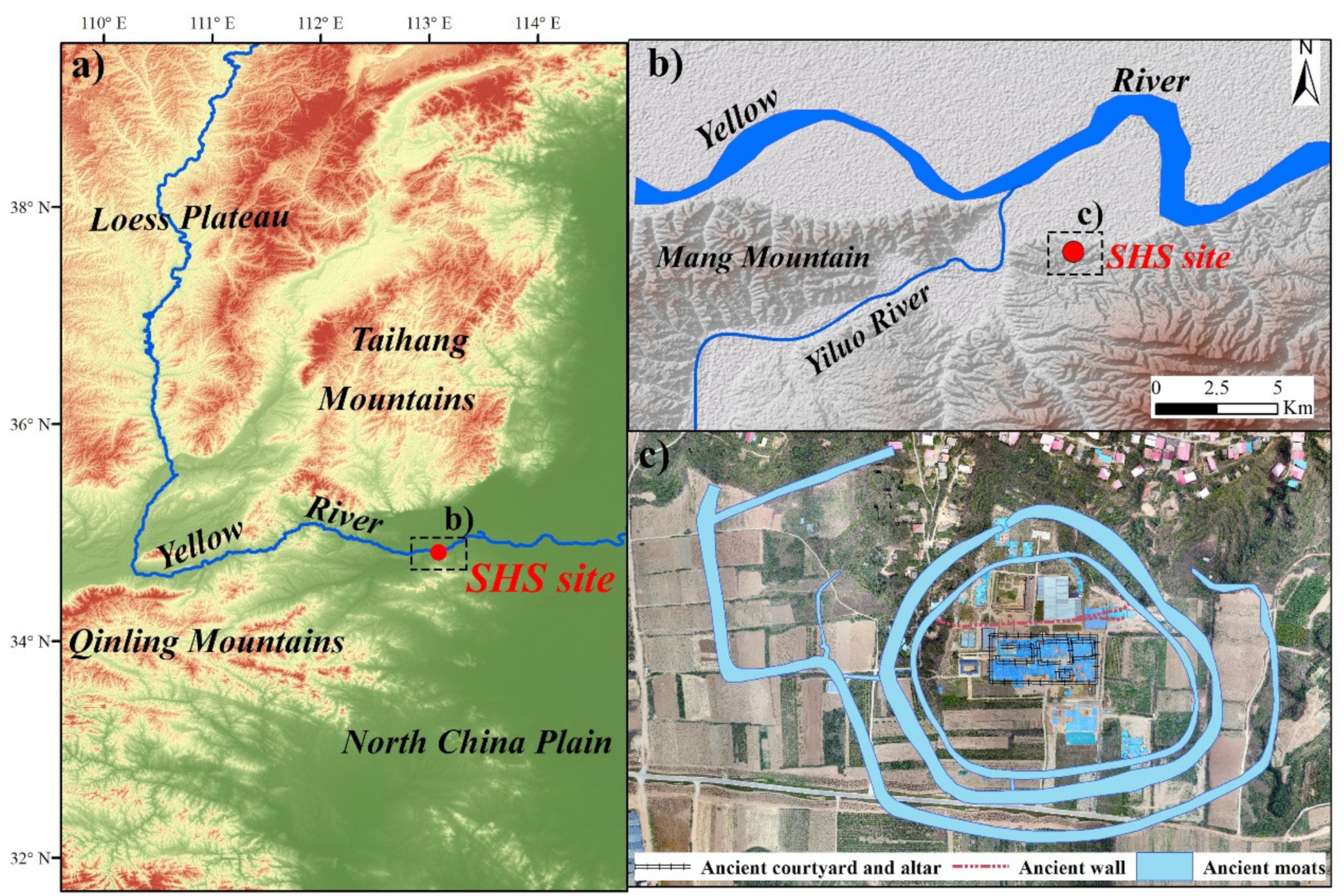



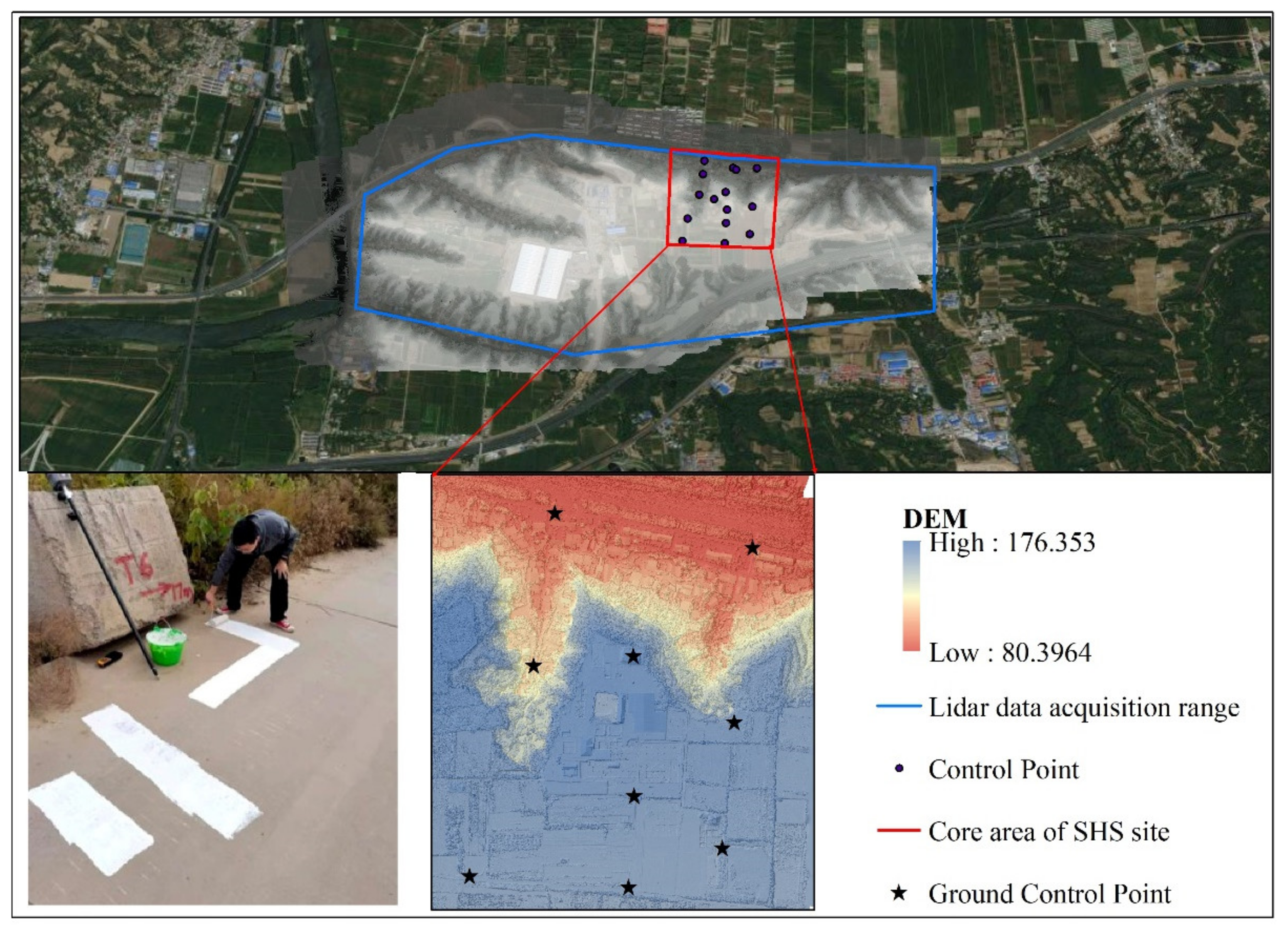

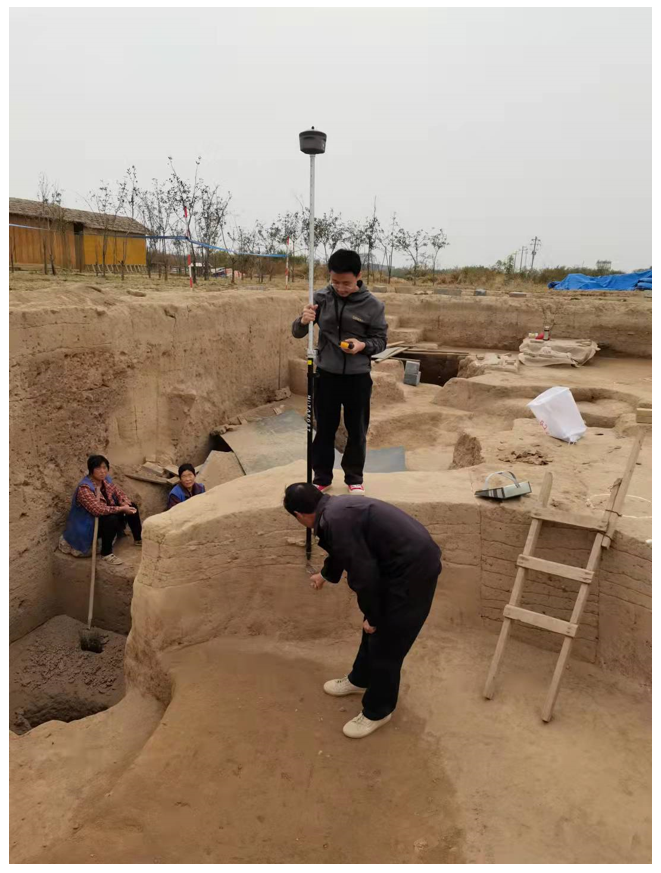

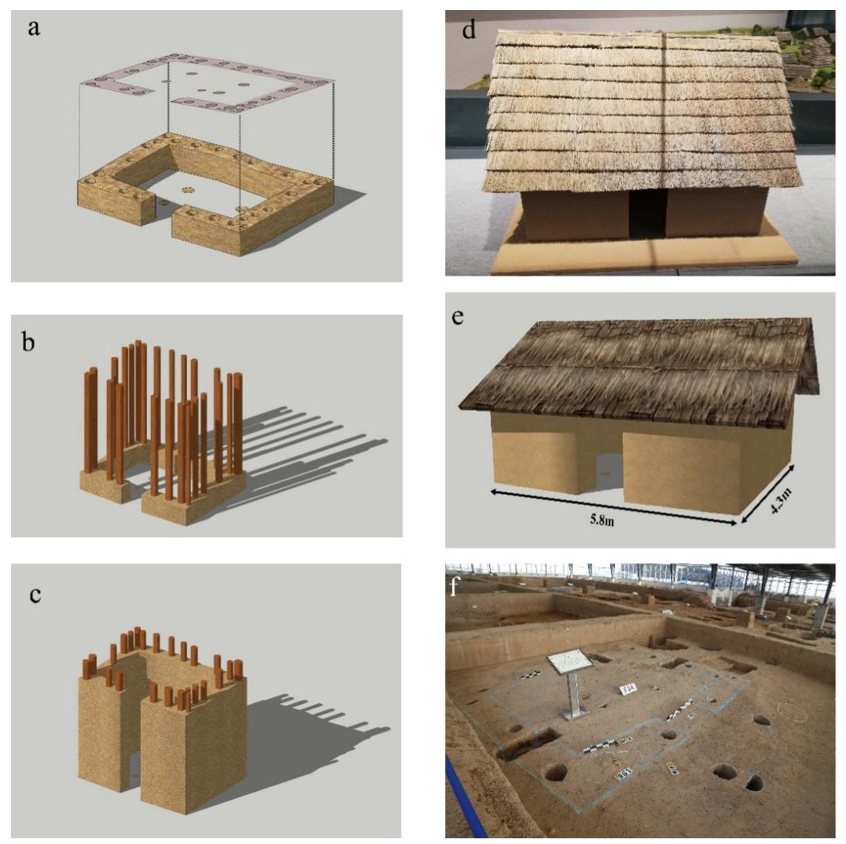

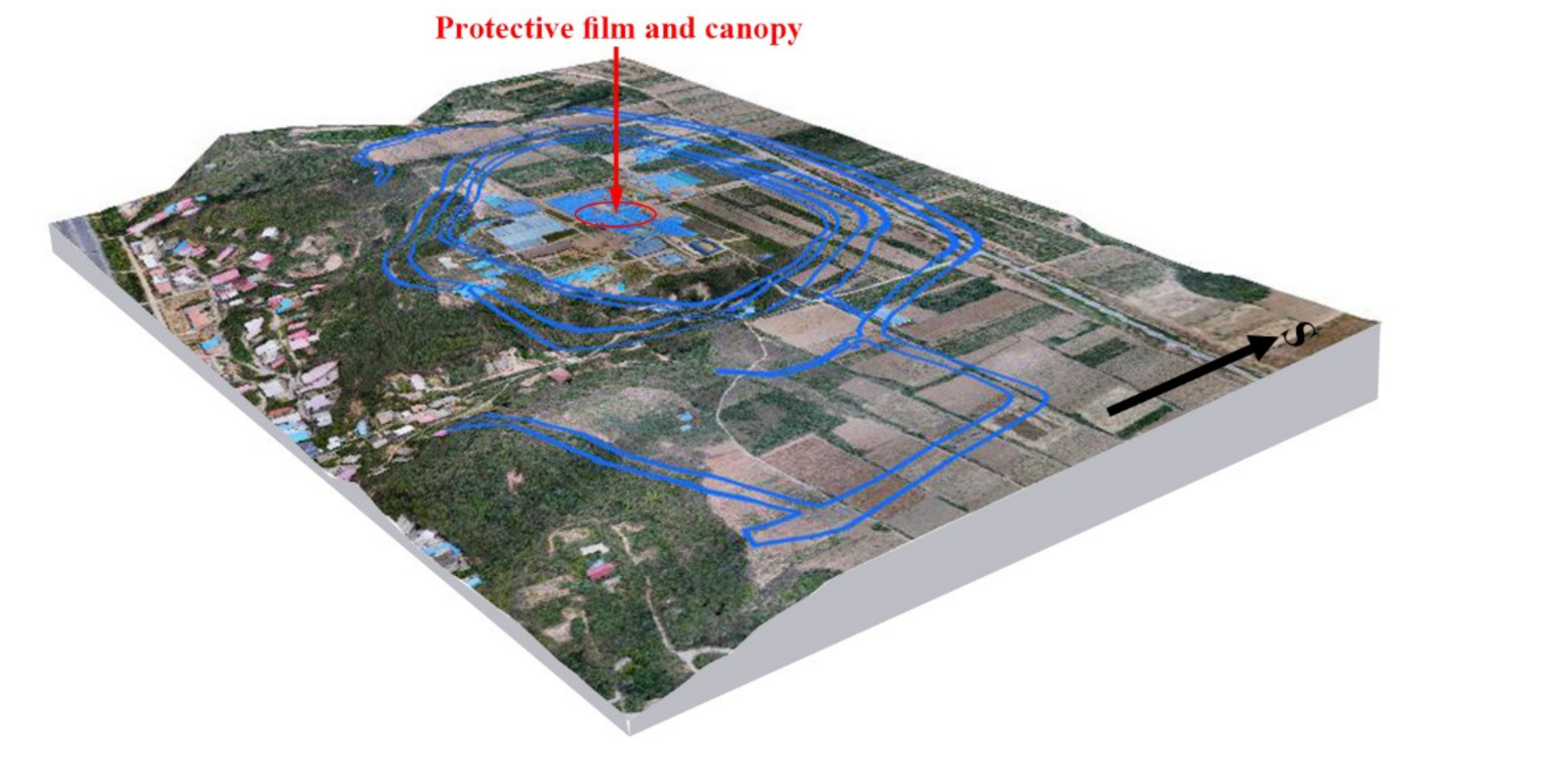

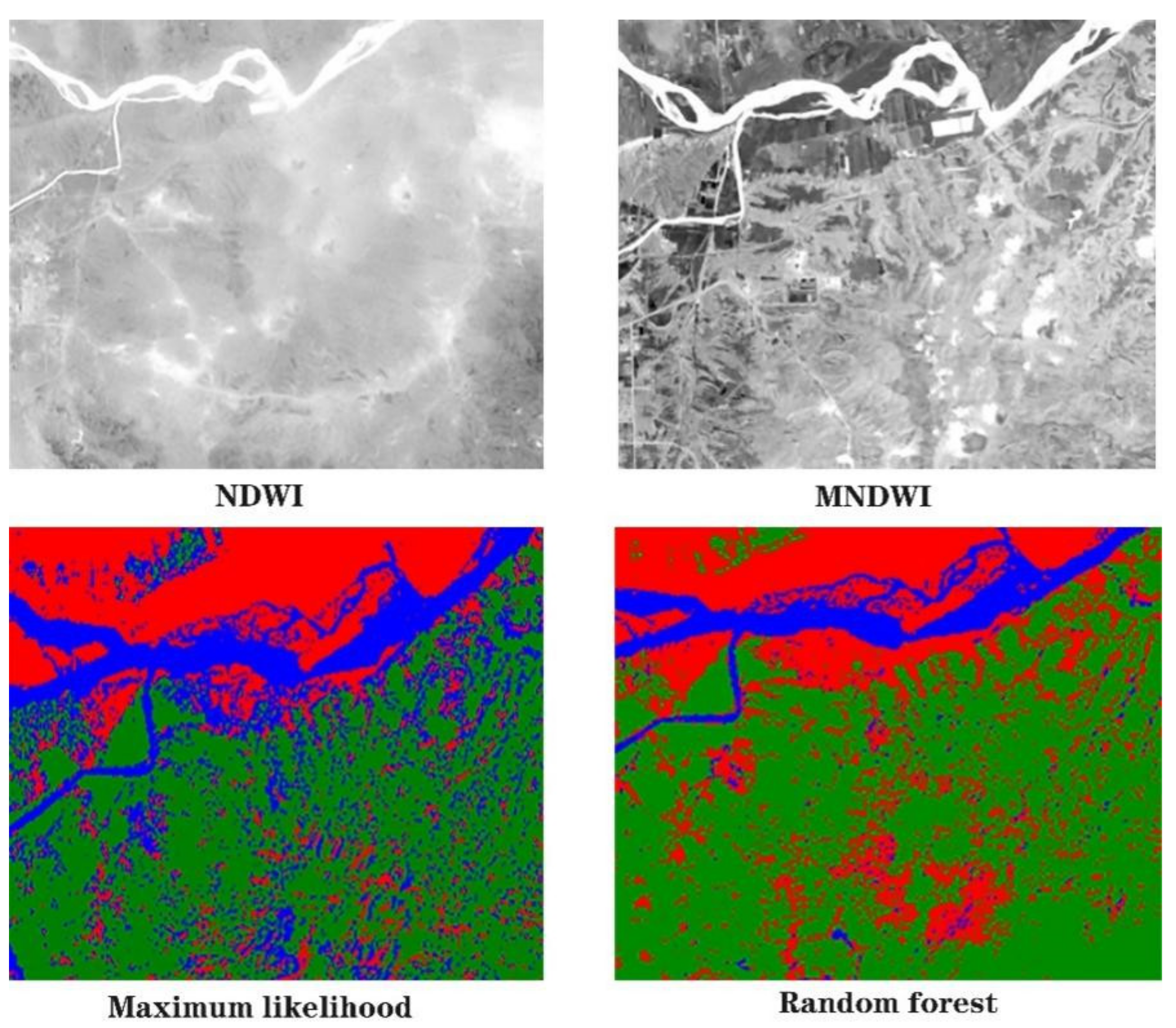


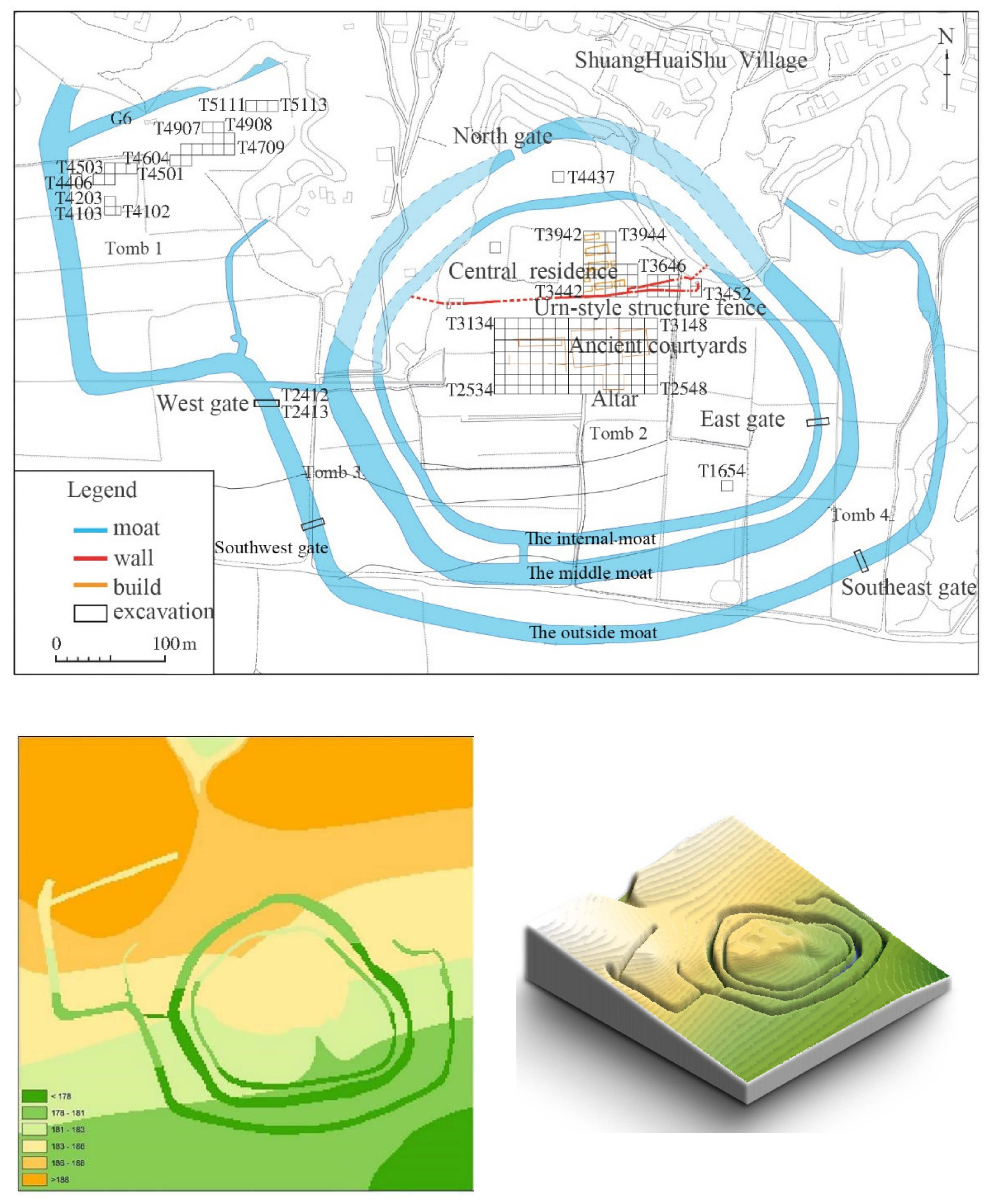
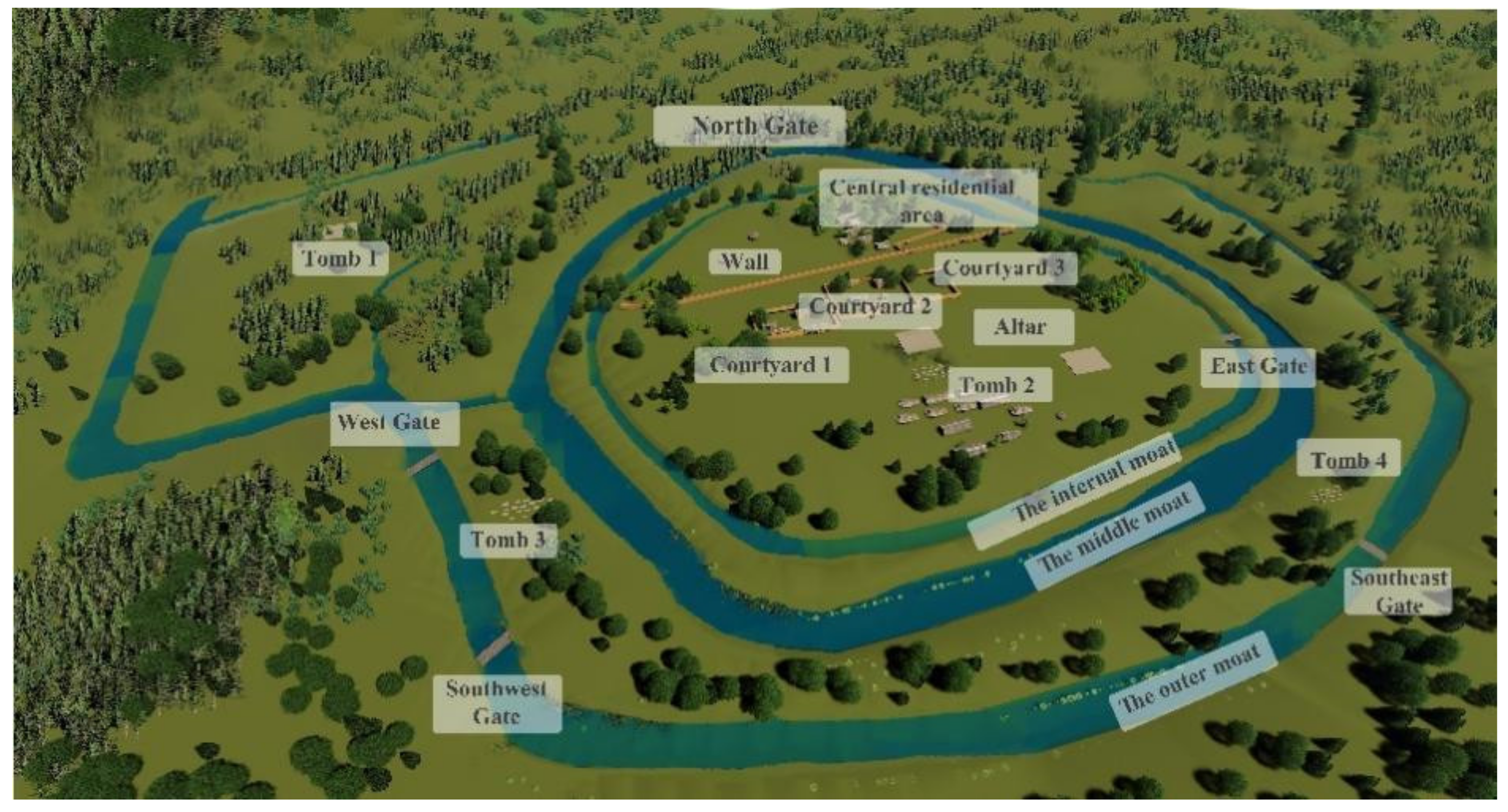
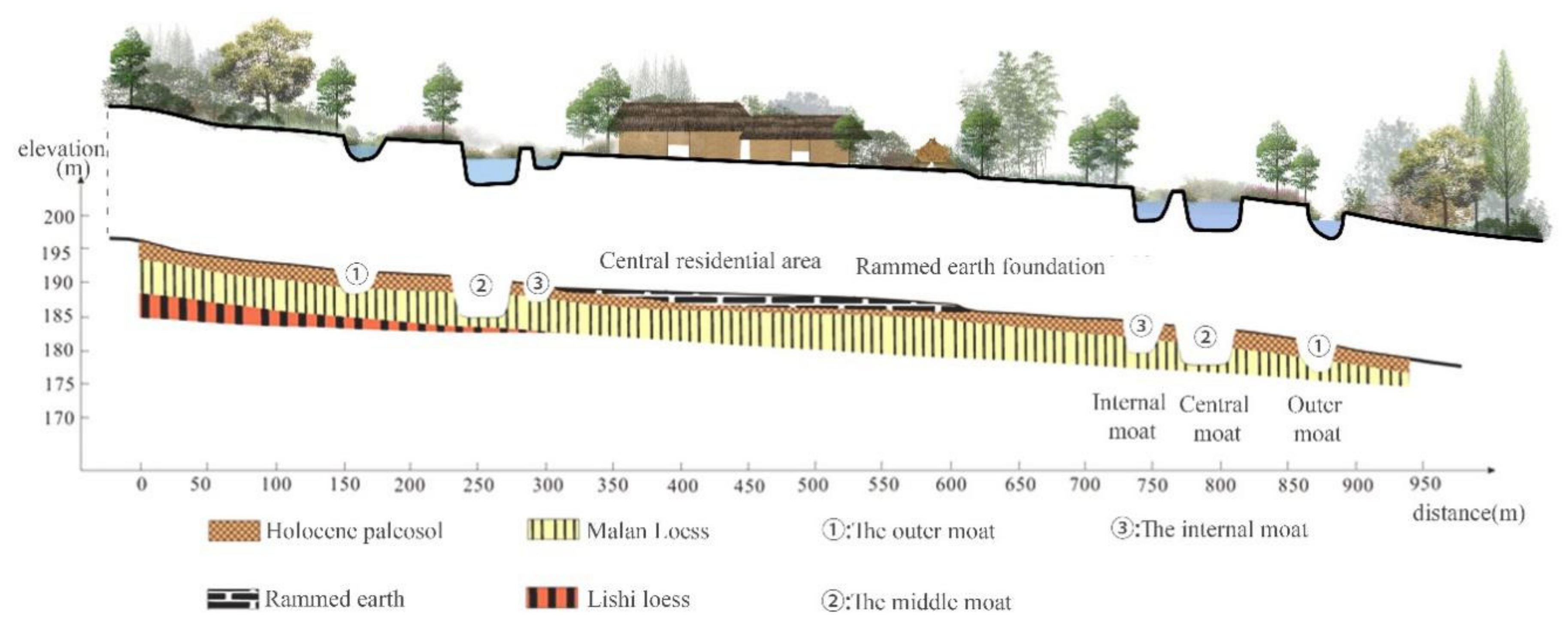

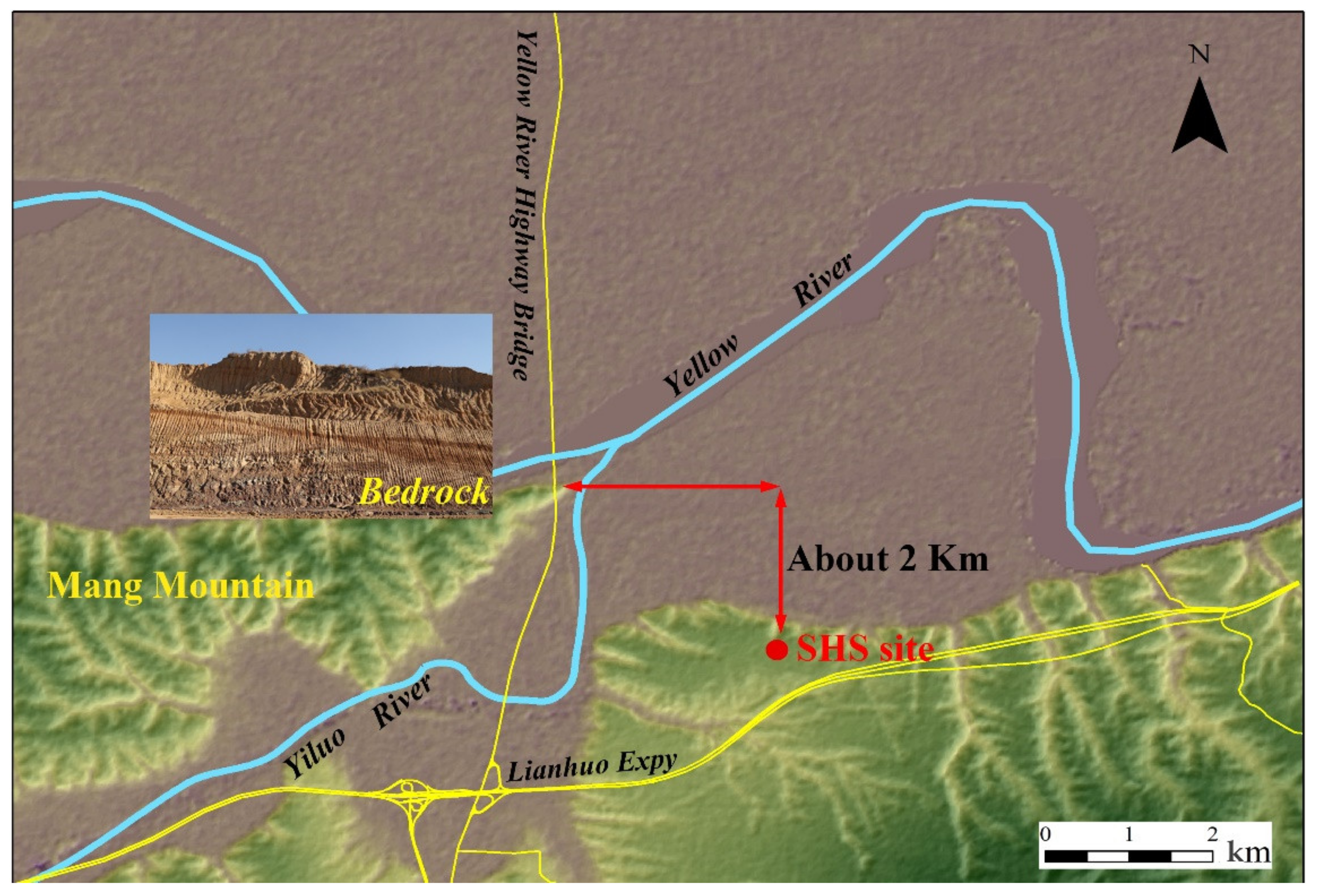
| Data Resource | Resolution/Accuracy | Time |
|---|---|---|
| CORONA images | 7.8/12.5 m | 1960s–1970s (18 April 1962, 26 July 1970) |
| Landsat5 images | 30 m | 1980s–2010s (9 April 1984, 11 May 1990, 11 June 2004, 15 June 2011) |
| Landsat8 images | 30 m | (9 July 2020) |
| ASTER DEM | 30 m | 2020 |
| ALOS DEM | 12.5 m | 2020 |
| DJI Genie RTK UAV | 4 cm | (21 November 2020) |
| Feima multirotor UAV D20(equipped with DV-Lidar20) | 5 cm | (28 September 2021) |
| GPS | 2 cm | (9 November 2020) |
| Total Station | 1 cm | (12 November 2020) |
| Pollen data | Samples taken, awaiting lab results | (9 October 2020) |
| Optically Stimulated Luminescence | Samples taken, awaiting lab results | (9 October 2020) |
| Time Period | Sporopollen Results | Climate and Landscape | References |
|---|---|---|---|
| 10,000 aBP | Trees account for more than half of the vegetation; coniferous pine and deciduous broad-leaved species that thrive in the temperature and humidity conditions of this time are dominant. Pollen records indicate that the herbaceous plants were dominated by the family Moraceae, followed by Artemisiaceae, Quinoa and Asteraceae. | The climate is dry and cool; the vegetation landscape consists of mixed forests and grasses. | [70,71,72,73] |
| 8000–6000 aBP | Broad-leaved trees and pine trees appear and subtropical pollen and water fern spores, such as those from maple and water cycad, are present. | The climate is warm and humid; the vegetation landscape consists of deciduous broad-leaved forest. | [70,71,73,74,75,76,77,78] |
| 6000–5000 aBP | Tree species, along with semihygrophytic and aquatic plants, dominate the pollen record. The pollen record is dominated by pine pollen, and the proportion of vegetation is low. | The climate is warm and humid; the vegetation landscape is dominated by pine trees, with some aquatic vegetation. | [74,75,78,79,80,81] |
| 4000–3000 aBP | The early and middle parts of this period are more suitable, and sporulation is dominated by grasses and trees. There is an overall decline in the vegetation population in the later parts of this period. | The climate is dry and warm; the vegetation landscape is dominated by grasses and trees, and the lake dries up at approximately 3000 aBP. | [82,83,84,85,86,87] |
Publisher’s Note: MDPI stays neutral with regard to jurisdictional claims in published maps and institutional affiliations. |
© 2022 by the authors. Licensee MDPI, Basel, Switzerland. This article is an open access article distributed under the terms and conditions of the Creative Commons Attribution (CC BY) license (https://creativecommons.org/licenses/by/4.0/).
Share and Cite
Chen, G.; Yang, R.; Lu, P.; Chen, P.; Gu, W.; Wang, X.; Hu, Y.; Zhang, J. How Can We Understand the Past from Now On? Three-Dimensional Modelling and Landscape Reconstruction of the Shuanghuaishu Site in the Central Plains of China. Remote Sens. 2022, 14, 1233. https://doi.org/10.3390/rs14051233
Chen G, Yang R, Lu P, Chen P, Gu W, Wang X, Hu Y, Zhang J. How Can We Understand the Past from Now On? Three-Dimensional Modelling and Landscape Reconstruction of the Shuanghuaishu Site in the Central Plains of China. Remote Sensing. 2022; 14(5):1233. https://doi.org/10.3390/rs14051233
Chicago/Turabian StyleChen, Guolong, Ruixia Yang, Peng Lu, Panpan Chen, Wanfa Gu, Xu Wang, Yayi Hu, and Jiqin Zhang. 2022. "How Can We Understand the Past from Now On? Three-Dimensional Modelling and Landscape Reconstruction of the Shuanghuaishu Site in the Central Plains of China" Remote Sensing 14, no. 5: 1233. https://doi.org/10.3390/rs14051233
APA StyleChen, G., Yang, R., Lu, P., Chen, P., Gu, W., Wang, X., Hu, Y., & Zhang, J. (2022). How Can We Understand the Past from Now On? Three-Dimensional Modelling and Landscape Reconstruction of the Shuanghuaishu Site in the Central Plains of China. Remote Sensing, 14(5), 1233. https://doi.org/10.3390/rs14051233





